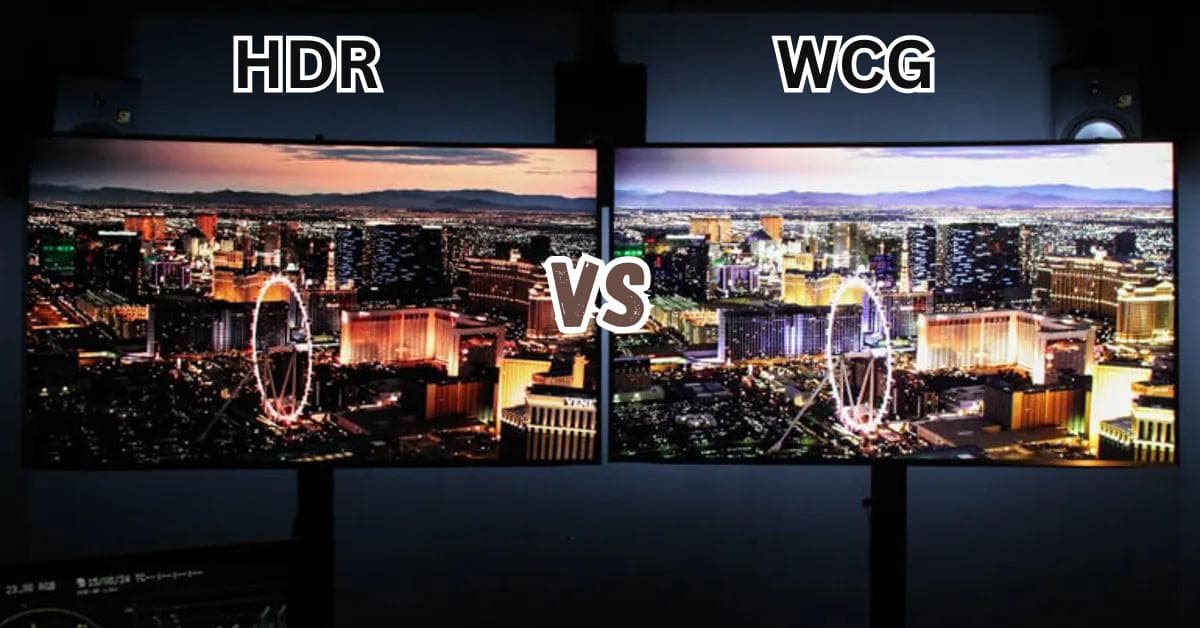
What is Wide Color Gamut (WCG)?
Wide Colour Gamut (WCG) is a term used to describe a colour space or colour gamut that covers a wider spectrum of colors than the typical colour gamut used in conventional displays and imaging systems. The sRGB (Standard Red, Green, Blue) colour space, which is widely used in consumer electronics and on the web, serves as the foundation for the standard colour gamut.
WCG technology, such HDR (High Dynamic Range) displays, make it possible to represent a broader range of colours, creating images that are brighter and more lifelike. These displays are able to represent a wider range of colours, including deeper, more saturated hues as well as subtler shades and nuances that were previously impossible with conventional displays.
How Does WCG Work?
When compared to conventional displays, Wide Colour Gamut (WCG) widens the spectrum of colours that can be shown on a screen. Here is a short description of how WCG technology operates:
- Colour Gamut: A display’s colour gamut refers to the range of colours it is capable of producing. The sRGB colour gamut, which denotes a common range of colours, is the one most frequently used in consumer electronics. WCG, however, seeks to surpass this benchmark.
- Increased Colour Space: WCG displays make use of technology that enable a wider colour space, which means they can reproduce more colours. Utilizing various backlighting technologies or colour filters, this is accomplished.
- Advanced Backlighting: Using advanced backlighting technologies, such as organic light-emitting diodes (OLEDs) or quantum dots, is one way to accomplish WCG. Small semiconductor particles known as quantum dots are used in quantum dot displays. When activated by light, quantum dots emit a variety of colours of light. The display may produce a larger variety of colours by utilizing quantum dots.
- Colour Filters: Using more complex colour filters is another method for achieving WCG. Red, green, and blue colours are created on traditional screens using colour filters. Improved or extra colour filters may be used by WCG displays to increase the number of colours that can be exhibited.
- Content Adaptation: In order to fully benefit from WCG, content must be specifically made or modified to make use of the wider colour gamut. This entails encoding the data using colour information from a larger range. If standard content is shown on a WCG screen in any other situation, the colours will be mapped or altered to fit inside the enlarged gamut, resulting in a less accurate portrayal.
Benefits of WCG
Wide Colour Gamut (WCG) has a number of advantages that improve colour representation in a variety of applications and the visual experience. Here are a few of WCG’s main advantages:
A greater spectrum of colours, including more saturated and vivid hues, as well as subtle tints and nuances, may be reproduced by WCG displays, which also have improved colour accuracy. With an enlarged colour palette, colours may be represented more accurately and more closely resemble how the human eye sees the world. Watching content that was especially made or modified for WCG results in more lifelike and engaging images.
Rich and Vibrant Colours: WCG displays may provide more vivid and rich colours due to their larger colour gamut. High-end photography, digital art, and HDR video are just a few examples of content that benefits greatly from this. These colours appear brighter and more striking thanks to WCG, which increases their visual impact.
What Exactly is HDR?
High Dynamic Range, sometimes known as HDR, is a technique that improves the contrast and dynamic range of pictures and movies. By enabling a wider range of brightness levels and more accurate colour representation, it enhances the entire visual experience.
Contrast and Dynamic Range: HDR increases the contrast by extending the range between the darkest and lightest areas of an image or video. This enables improved shadow and highlight detail preservation and display, resulting in a more lifelike and immersive viewing experience. The wider dynamic range prevents highlights from becoming washed out and dark regions from losing information.
Brightness Levels: When compared to regular displays, HDR displays are able to reach higher peak brightness levels. As a result, scenes with high contrast ratios can have highlights that are brighter. The increased brightness makes the visual display more striking and livelier.
How Does HDR Work?
A greater dynamic range and better colour representation are achieved by recording, processing, and displaying photos and movies using the HDR (High Dynamic Range) technique. Here is a short description of how HDR technology functions:
Utilizing cameras or sensors with HDR capabilities, the process begins with the capture of the content. By employing strategies like numerous exposures or boosting the bit depth of the collected data, these devices are made to capture a wider range of brightness levels.
Expanded Dynamic Range: To capture a greater dynamic range, HDR content combines multiple exposures of the same scene. In contrast to conventional imaging, it catches features in the scene’s darkest and brightest sections while conserving more data.
Benefits of HDR
A number of advantages provided by HDR (High Dynamic Range) technology considerably improve the visual experience when consuming HDR video. Here are some of HDR’s main advantages:
Enhanced contrast is made possible by HDR’s wider dynamic range, which makes it easier to distinguish between an image’s darkest and brightest areas. As a result, the contrast is boosted, producing darker blacks and brighter highlights. A more immersive and realistic viewing experience is created by the increased prominence of details in both bright and shaded sections of the image.
Increased Depth and Detail: HDR preserves more detail, especially in areas of extreme brightness or darkness. More minute details, complex patterns, and lifelike nuances can be seen. A more fascinating and engaging visual experience is made possible by the increased depth and amount of detail.
HDR Format
Typically, HDR content is encoded or prepared in accordance with established HDR formats or standards. These formats guarantee HDR-compatible device compatibility and reliable playback. Here are a few popular HDR file types: HDR10: The most extensively used HDR format, HDR10 is an open standard. Because it employs static metadata, the brightness and colour information for the entire piece of content are pre-set. A large colour gamut is supported by HDR10, which calls for a minimum of 10 bits per colour channel. It is supported by a large selection of media players, streaming services, and screens with HDR capabilities.
Dolby Laboratories created the exclusive HDR format known as “Dolby Vision.” In order to maximize the HDR experience, it provides dynamic information that enables scene-by-scene or frame-by-frame modifications. A large colour gamut is supported by Dolby Vision, which calls for a minimum of 12 bits per colour channel. It is supported by a few TVs, streaming services, and media players and is renowned for its sophisticated picture processing.
The Difference Between HDR and WCG
While WCG focuses on extending the range of colours that can be displayed on a display, HDR focuses on extending the dynamic range and enhancing contrast in an image or video. They are frequently combined to convey content in a more accurate and visually appealing manner. While WCG enriches the colour accuracy and vibrancy of the projected material, HDR improves contrast and preserves detail to improve the entire visual experience.



